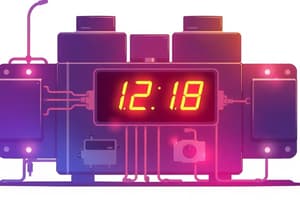Podcast
Questions and Answers
What is the purpose of a rectifier?
What is the purpose of a rectifier?
A rectifier converts alternating current (AC) to direct current (DC).
Which of the following is NOT a type of rectifier?
Which of the following is NOT a type of rectifier?
- Mercury-arc valves
- Solid-state diodes
- Resistors (correct)
- Silicon-controlled rectifiers
- Vacuum tube diodes
Why are rectifiers crucial in electronic devices?
Why are rectifiers crucial in electronic devices?
Most electronic devices cannot handle high voltage or alternating current due to the risk of damage. Rectifiers convert AC to DC, ensuring safe and efficient operation.
What is meant by 'rectification'?
What is meant by 'rectification'?
What is the primary application of a rectifier?
What is the primary application of a rectifier?
A full-wave rectifier utilizes only half of the input AC cycle.
A full-wave rectifier utilizes only half of the input AC cycle.
What is the advantage of a full-wave rectifier over a half-wave rectifier?
What is the advantage of a full-wave rectifier over a half-wave rectifier?
What are the key elements of a full-wave rectifier circuit?
What are the key elements of a full-wave rectifier circuit?
How does a full-wave rectifier work?
How does a full-wave rectifier work?
Why is a capacitor used in a full-wave rectifier circuit?
Why is a capacitor used in a full-wave rectifier circuit?
What are some applications of full-wave bridge rectifiers?
What are some applications of full-wave bridge rectifiers?
How do rectifiers help with transformers?
How do rectifiers help with transformers?
Why is a half-wave rectifier suitable for AM radio?
Why is a half-wave rectifier suitable for AM radio?
What is a major disadvantage of using a rectifier to power devices?
What is a major disadvantage of using a rectifier to power devices?
Rectifiers are essential for the operation of any power supply that utilizes AC voltage.
Rectifiers are essential for the operation of any power supply that utilizes AC voltage.
What is the role of a voltage regulator in a rectifier circuit?
What is the role of a voltage regulator in a rectifier circuit?
Which of the following is NOT a common source of information about rectifiers?
Which of the following is NOT a common source of information about rectifiers?
Flashcards
What is a rectifier?
What is a rectifier?
An electronic component that converts alternating current (AC) into direct current (DC).
What is rectification?
What is rectification?
The process of converting AC to DC is called rectification.
What is a full-wave rectifier?
What is a full-wave rectifier?
A full-wave rectifier converts the entire AC waveform into pulsating DC, utilizing both positive and negative cycles.
What is a half-wave rectifier?
What is a half-wave rectifier?
Signup and view all the flashcards
What is the main function of a diode in a rectifier circuit?
What is the main function of a diode in a rectifier circuit?
Signup and view all the flashcards
What is a center-tapped transformer in a full-wave rectifier?
What is a center-tapped transformer in a full-wave rectifier?
Signup and view all the flashcards
What is a bridge rectifier?
What is a bridge rectifier?
Signup and view all the flashcards
What is filtering in a rectifier circuit?
What is filtering in a rectifier circuit?
Signup and view all the flashcards
What is a capacitor used for in a rectifier circuit?
What is a capacitor used for in a rectifier circuit?
Signup and view all the flashcards
What is a resistor used for in a rectifier circuit?
What is a resistor used for in a rectifier circuit?
Signup and view all the flashcards
What is voltage regulation in a rectifier circuit?
What is voltage regulation in a rectifier circuit?
Signup and view all the flashcards
What is a voltage regulator?
What is a voltage regulator?
Signup and view all the flashcards
What are some applications of a half-wave rectifier?
What are some applications of a half-wave rectifier?
Signup and view all the flashcards
What are some applications of a full-wave rectifier?
What are some applications of a full-wave rectifier?
Signup and view all the flashcards
Where are rectifiers commonly used?
Where are rectifiers commonly used?
Signup and view all the flashcards
What is the role of a rectifier in a power supply unit?
What is the role of a rectifier in a power supply unit?
Signup and view all the flashcards
What is the role of a rectifier in welding?
What is the role of a rectifier in welding?
Signup and view all the flashcards
What are the disadvantages of a full-wave rectifier?
What are the disadvantages of a full-wave rectifier?
Signup and view all the flashcards
What are the advantages of a full-wave rectifier?
What are the advantages of a full-wave rectifier?
Signup and view all the flashcards
What is the ripple factor in a full-wave rectifier?
What is the ripple factor in a full-wave rectifier?
Signup and view all the flashcards
What is the role of a rectifier in demodulation?
What is the role of a rectifier in demodulation?
Signup and view all the flashcards
What is the main benefit of a rectifier?
What is the main benefit of a rectifier?
Signup and view all the flashcards
What is the output of a rectifier like?
What is the output of a rectifier like?
Signup and view all the flashcards
What does a voltage regulator do?
What does a voltage regulator do?
Signup and view all the flashcards
What is the purpose of a filter in a rectifier circuit?
What is the purpose of a filter in a rectifier circuit?
Signup and view all the flashcards
What role does a diode play in a rectifier?
What role does a diode play in a rectifier?
Signup and view all the flashcards
What is the purpose of a center-tapped transformer?
What is the purpose of a center-tapped transformer?
Signup and view all the flashcards
What is the main advantage of a bridge rectifier?
What is the main advantage of a bridge rectifier?
Signup and view all the flashcards
Study Notes
Project Report: Rectifiers
- Aim: To construct a full-wave rectifier and demonstrate the conversion of alternating current (AC) to direct current (DC). The aim also includes understanding rectifiers, center-tapped full-wave rectification, and bridge full-wave rectification.
Introduction
- A rectifier is an electrical component that changes alternating current (AC) to direct current (DC). It acts like a one-way valve for electricity.
- Rectifiers have various forms including solid-state diodes, vacuum tube diodes, and semiconductor switches.
- Electronic devices often cannot handle high alternating current or high voltage; rectifiers provide a solution.
- Rectifiers are crucial in devices like TVs, radios, and chargers because of battery replacement issues.
Materials Required
- Connecting wires
- Plug
- Wires (2 meters)
- Nuts and bolts (2-3cm length)
- Circuit board
- Transformer (12V)
- Resistor
- PN junction diodes (4)
- LED
- Insulation tape
- Soldering tools and wax
- Solder lead
- Sandpaper
Circuit Diagram
- The document includes a circuit diagram of a full-wave rectifier.
- This shows the connections for AC input (transformer), components like diodes, a resistor, and output(load).
Connection Details
- The AC power supply is connected to the transformer input.
- The transformer secondary coil is connected to the diodes.
- The diodes are connected to a capacitor and resistor.
- The resistor is connected to outputs for measurement(to a bulb).
Half Wave Rectifier
-
Converts AC to DC using only one diode.
-
Only allows half of the AC wave to pass to the DC output (creates a waveform that's not completely constant)
-
A capacitor is usually added to smooth the output.
-
Applications: rectification, signal demodulation, signal peak detection
-
Advantages: Simple design and cheaper than other types
-
Disadvantages: Inefficient (only half the AC cycle is processed, leads to half the power output), prone to fluctuations.
Full Wave Rectifier
- Converts AC to DC using two diodes or a bridge rectifier circuit.
- A capacitor can be placed in the circuit to further smooth the DC output, producing a steadier flow.
- Applications: Identifying modulating signal amplitude in radio signals, power supply circuits supporting various devices (those requiring DC voltage). Useful for LED and motor applications.
- Advantages: Higher efficiency, lower ripple factor than half-wave, use both half-cycles thus maximum possible output.
- Disadvantages: More complex circuit, more expensive than a half-wave circuit, requires more components.
- Working: A transformer steps down voltage. The four diodes conduct current in one direction during each half cycle to produce a constant DC output.
Observation and Result
- Connecting a voltmeter to the full-wave bridge circuit exhibits a steady 12V output current.
Applications and Uses of Rectifiers
- Used to convert AC to DC for various electronic appliances.
- Found in power supplies for most electronic equipment.
- Help smooth out fluctuations in AC voltage to achieve more constant DC output.
Conclusion
- Rectifiers are crucial in all electronics that run from AC but require DC.
- A filter removes the alternating current characteristics of the output and produces a smooth DC current.
- Regulators provide stable voltage, regardless of changes in the input (line voltage or load).
Bibliography
- Physics NCERT Book Grade 12
- Wikipedia
- GeeksForGeeks
- Byjus
- www.olabs.edu.in
Studying That Suits You
Use AI to generate personalized quizzes and flashcards to suit your learning preferences.




